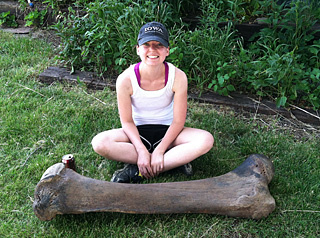An Iowa farmer and his family discovered an assortment of mammoth bones in their backyard; they hope assistance from the University of Iowa will uncover many more.
The UI Museum of Natural History, with the cooperation of the Department of Geoscience and the Office of the State Archaeologist, is organizing the ongoing excavation and scientific evaluation of the find.

The farmer, identified only as John, and his sons were out looking for berries near their home in Oskaloosa two years ago when they stumbled on what appeared to be an enormous bone sticking out of the dirt.
"I got down on my hands and knees on the bank and could see a marrow line and I said, ‘Boys, that's a bone—that's a really big bone,'" John told ABC affiliate WOI-TV.
For the past two years, John and the family kept relatively quiet about the discovery, but they recently decided to enlist the help of UI experts to aid in the excavation.
So far nearly 30 bones have been recovered, including an impressive femur, multiple ribs and vertebrae, and a few toe bones—and the digging has just begun. A recent UI Museum of Natural History excavation yielded two ribs, two wrist/ankle bones, and some fragmented vertebrae.
The discovery of both large and small bones within the same area is important as it means the mammoth was buried where it died, with little bone displacement—the entire skeleton may still be in the same area. University scientists recently took images of the entire site using ground-penetrating radar to gauge how much of the mammoth still needs to be uncovered.
Holmes Semken, professor emeritus of geoscience in the UI College of Liberal Arts and Sciences, says the radar surveying went well; Frank Weirich, associate professor of geoscience and civil and environmental engineering, is pleased with the raw data. A better picture of what lies below the earth should be forthcoming.
“The discovery of an apparently complete mammoth, or at least a sizable portion of one, is most unusual,” Semken says.
Although mammoth bones aren’t too uncommon in this area, finding a mostly complete, largely undisturbed skeleton is extremely rare. While there are quite a few records of mammoths from Iowa, almost all are individual bones.The combination of the completeness of the skeleton and the wealth of other information available at the site could make this the most important mammoth discovery in Iowa.
“The discovery is a benefit for the Museum of Natural History because the landowner has donated the science associated with the beast,” Semken adds. “We will be able to test the bones for carbon, nitrogen, and oxygen isotopes. This data will give insight into the temperature of the water the animal drank, the kinds of plants it ate, and its time of death, probably within 50 years.”
Researchers have also taken soil and botanical samples in order to help identify how the land looked when this mammoth roamed Iowa. This is crucial for UI scientists who are not only interested in the mammoth but also the environment in which this animal lived and died.
A few bone specimens are of special interest as they show what look to be gnaw marks, potentially indicating the mammoth decayed and was partially consumed by ice-age carnivores before burial.
This find has great educational potential. Sarah Horgen, Museum of Natural History education coordinator, says, “We are excited about the scientific research that will come from this site, but also about how we can use the excavation and research as an educational tool to show Iowans the natural history that is right under their feet.
“We have already lined up teachers and students from all levels to help with future digs, and more are contacting us every day wishing to participate. I am so grateful to the landowner for making this unique opportunity possible, and thrilled about the interest from students and educators across the state.”